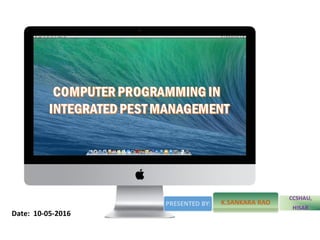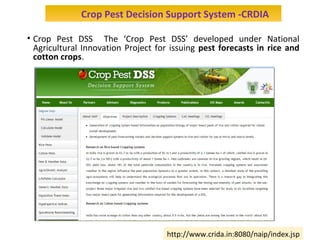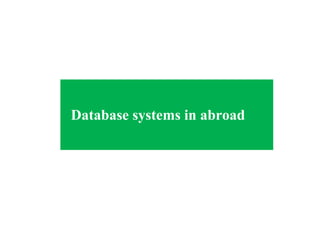Computer programming in ipm
- 2. Computer programming is the process of designing, writing, testing, debugging and maintaining the source code of computer programmes. It involves writing source code in programming languages with an aim to create a set of instructions that computers use to perform specific operation. Other two terms often used are database and database management system. An organised collection of data for one or more purpose usually in digital form is known as database. The use, creation and maintenance of the database using software packages with computer programmes is called as Database Management System(DBMS). The acronym’’ DBMS” is universally understood with Information technology(IT) (Dhaliwal et al., 2013)
- 4. • Computer applications in Integrated Pest Management, popularly known as IPM informatics.
- 5. DDATA DATA SYSTEM SOFTWARE Data creation Data update Generation of document Summary, Analysis Chart& report generation What- if ? Analysis& Decision support Information searching • Collection of interrelated data and a collection of programmes to access that data • A suitable software package – starting point of data base system • Database systems use a similar set of commands and functions • Data & procedures for maintaining and using the data files are the two parts of database systems
- 7. • Mealybug Awareness programme for Punjab (2008) • e-pest surveillance of soyabean and cotton in maharastra (2009-2010) • Awareness-cum-surveillance programme for the management of major pests of rice in Odisha (Kharif,2011) 1. Database on package of practices of Indian crops 2. Crop Pest Surveillance and Advisory Project (CROPSAP) - Maharashtra 3. Horticulture Pest Surveillance and Advisory Project (HortiSAP) - Maharashtra 4. Online Pest Monitoring and Advisory Services (OPMAS) 5. e-National pest reporting and alert system for pigeonpea and chickpea 6. Pest and disease dynamics in relation to climate change 7. Expert System for Brinjal and Tomato
- 8. Mealybug Awareness programme for Punjab (2008) Sudden emergence of mealy bug during 2006-07 and 2007-08 in Gujarat and Punjab was increased the cost of plant protection. Weekly data on mealy bug was collected from 320 villages in eight districts of Punjab through mail which was processed and put on the NCIPM website In Mealy bug Awareness Programme – Punjab, four trainings of two days each were conducted and 1000 copies each of Hindi and Punjabi DVDs on “Kapas mein mealy bug ka samekeet prabhandhan” were made and distributed to all State Agricultural Departments, CIPMCs, SAUs, Private seed and pesticide industry representatives, NGOs, etc. An online software programme was developed in the NCIPM website i.e., www.ncipm.org.in/NISPM in 2008. (Annual Report NCIPM,2008-09)
- 9. e- pest surveillance of soyabean and cotton in maharastra (2009-2010) E-pest surveillance system was implemented in 30 lakh hectares each of soybean-cotton and 10 lakh hectares each of pigeonpea and chickpea in Maharashtra during Kharif and Rabi seasons, respectively. Fig: Impact of Surveilance on Soyabean production Annual report-NCIPM (2010-11)
- 10. • A total of 10 % of the total area of 17.38 lakh ha paddy spread over 17606 villages in 13 intensive rice growing districts was sampled for 23 pests on weelkly basis. • The programme resulted in the development of centralized database and client software, online reporting, advisory and tracking system, GIS based mapping system, and display of current and the entire season’s pest scenario on NCIPM website. Annual Report-NCIPM (2011-12)
- 11. Information is available on pest, disease management, nutritional deficiency and physiological disorder in different crops being grown in India (www.ncipm.org.in/agroweb)
- 12. CROPSAPCROPSAP Crop pest surveillance and advisory project (CROPSAP) for soybean, cotton, rice, pigeonpea and chickpea in Maharashtra has been implementing from 2008-2009.
- 13. With help of Department of Horticulture, Govt. of Maharashtra Horticulture Pest Surveillance and Advisory Project (HortiSAP) covering mango, pomegranate, Banana, santra and sweet orange in 3,61,647 ha. HORTSAPHORTSAP Annual report NCIPM (2014-2015)
- 14. GIS based automated pest mapping in Maharastra Started in the year:2010
- 15. OPMASOPMAS
- 16. e-National pest reporting and alert system for pigeonpea and chickpea Started in the year 2010 for Accerelating the pulse production This system is proactive http://www.ncipm.org.in/A3P/ UI/HOME/Login.aspx) and has inbuilt system of decision support system and dissemination of Advisories to individual farmers through SMS (containing warning as well as advisories in local languages). A total of 10767 SMSs in the form of crop health management advisories were sent to the farmers of 13 states in different regional languages.
- 18. (http://www.ncipm.org.in/nicra/ForewarningSystem/Technologies.asp) • Real time pest surveillance (RTPS) in ‘pest and disease dynamics in relation to climate change’ under NICRA • NCIPM-NICRA Pest and disease forewarning for target crops (rice, pigeonpea, groundnut and tomato) using modeling approaches.
- 21. • Crop Pest DSS The ‘Crop Pest DSS’ developed under National Agricultural Innovation Project for issuing pest forecasts in rice and cotton crops. Crop Pest Decision Support System -CRDIA http://www.crida.in:8080/naip/index.jsp
- 22. (http://www.drmr.res.in/fasalsuraksha/index.php) Database containing information about 11 diseases and 10 insect of rapeseed-mustard and 80 color images of various symptoms of diseases and insect- pest. The system involves two main sub-tasks, namely, diagnosis and management.
- 23. It is a web-based application system developed by the University of Agricultural Sciences, Raichur- Karnataka. It facilitates flow of information from the farmer to the farm scientist and back. "The idea behind creating e-SAP was to help the extension worker, to collect specimens right from the farmer's field and send it to the scientists and experts in real time, e-SAP will make the work of the extension service worker easy, enhance their efficiency and at the same time provide the farmers with solutions right in his field in real time. it has a voice-based application system, which guides the farmer and the extension worker in the local language about how to collect the data and the specimens. It also allows the extension worker and the farmer to do a survey of the pest attack or related problems right in the field, which is then automatically synthesised in the form of graphs and tables along with the decision support intelligence Electronic Solutions against Agricultural Pests (E-SAP)Electronic Solutions against Agricultural Pests (E-SAP)
- 24. ADVISORY SURVEILANCE UNKNOWN PEST FARMER DETALIS
- 25. Data retrival GIS maps Graphs Raw data
- 29. With a view to provide technical knowledge to the extension functionaries and farmers in the States, Directorate of P.P.Q&S. has developed 77 IPM package of practices for different crops with the latest research inputs from State Agricultural Universities (SAUs) and Indian Council of Agricultural research (ICAR) http://farmer.gov.in/ipmpackageofpractices.html
- 30. ikisan is an agricultural portal maintaining by the Nagarjuna Fertilizers and Chemicals limited. It provides online, detailed content on crops, crop management techniques, fertilizers & pesticides and a host of other agriculture related material. Latest updates on related markets, products, weather forecasts are also available Enable the farmers to net work with other farmers, suppliers and consumers across the world http://www.ikisan.com/agri-informatics.html
- 31. Services started from 1986-87
- 32. Database systems in abroad
- 33. EPPO is an intergovernmental organization responsible for European cooperation in plant protection in the European and Mediterranean region. EPPO maintain the following Data bases: EPPO standards on efficacy evaluation of plant protection products PQR-EPPO database on quarantine pests EPPO Plant Protection Thesaurus EPPO database on Diagnostic expertise
- 35. Distance Diagnostic and Identification System • The web based Distance Diagnostic and Identification system (DDIS) provides a colloboration and communication tool for extension agents, first detectors, specialists and diagnosticians to share information on plant diseases and other pests In Florida • The system uses field data and digital media as a tool for enhancement of diagnosis of plant disease, insect, weed, invasive species, plant management, physiology and nutrient problems. (http://edis.ifas.ufl.edu/topic_ddis)
- 38. • Appropriate Technology Transfer for Rural Areas (ATTRA) is a program developed and managed by the National Center for Appropriate Technology (NCAT). Headquartered in Butte, Montana. • NCAT developed a database highlights reduced risk materials that can be integrated with ecological pest management strategies.
- 39. Database developed by IOBC Categorize the pesticides into different toxicity classes based on lethal as well as sublethal effects on natural enemies (http://www.iobc-wprs.org/ restricted_member/toolbox.cfm)
- 40. • Developed by Deparment Of Natural Resources And Environmental Sciences, University Of Illinois Practical goal EDWIP offers information on fungi, viruses, protozoa, mollicutes, nematodes, and bacteria that are infectious in insects, mites, and related arthropods EDWIP also includes the information on where associations have been observed, stages and tissues of hosts infected and habitats and host ranges of arthropod hosts Improving and expending microbial control of arthropod pests Assesing potential risks posed by microbial control agents (http://insectweb.inhs.uiuc.edu/pathogens/edwip)
- 41. • Based on integrating e- mail, web sites and data bases, provides an electronic means for sharing immediate pest out break alerts, forecasts and other timely information between growers, field personnel, extensionists, and researchers • The system encourages to improve pest management decision- making by stakeholders • Provide information on pest development status and build up levels of bio control agents, and other pest- related occurences • This integrated system encourages development of area wide integrated pest management programs (http://ippc.orst.edu/pestalert)
- 42. www.ipmnet.org/index.htm Rich source of IPM resources Web links are available for getting information from national as well as international organizations.
- 43. Developed by USDA The vary purpose of the EIPMDSS program is to support development of expert systems that help, guide, demonstrate and multiply impacts of USDA supported IPM programs IPM PROGRAMS thus facilitate 1.Improve cost benefit analyses 2.Reduce human health risks from pests and related management strategies 3.Minimize adverse environmental effects from pests and related management strategies (USDA, 2012)
- 44. Model: A model is a simplified representation of a system or a process. These are conceptual or mathematical devicies that aim to describe or stimulate natural processes. PEST MODEL : Any representation of one or several processes associated with pest development & control is termed as pest model These tools will provide a special form of information A great advantage of computer modelling is that it permits experimentation with mathematical representations of real- world systems which would be risky, difficult and expensive with actual systems Models can be used and categorized according to particular needs and perspectives
- 46. Statistical Models Commonly used for system analysis Regression models Multiple regression models Experimental designs These are purely based on empherical observations 1. Statistical models :
- 47. 2. Mechanistic Models • It deals with biological & ecological mechanisms or process that underline pest population dynamics, damage and control. • More suitable for expressing hypothesis about the reasons for pest outbreaks It • includes: Analytical models Simulation models Rule-based models Phenological models Inferential modes Spread sheet based models
- 48. A) Analytical Model These are mathematical models based on differential equation the results of the models can be written as algebraic expression involving parameter values These are used as tools for developing pest management principles & ecological theory Use: developing host parasitoid relationship for sustainable bio control
- 49. B) Simulation Models: Simulation models Most widely used in Agricultural Pest management. It involves simulation of the population dynamics of crops, pest, natural enemy of the pests or combination of these. Used for forecasting of pest population changes
- 50. Conclusions Computer programming enables collaboration and information sharing on an unprecedented scale. Becoming a prime medium for research and extension communication. No other medium offers such ability as simultaneous real-time weather information, multimedia, analytical processing and multi-way discussion and feedback Many of the resources are available but there is need for proper integration Future advances in IT and computer programming would lead to precision In pest forecasting and develop sustainable pest management.


















































